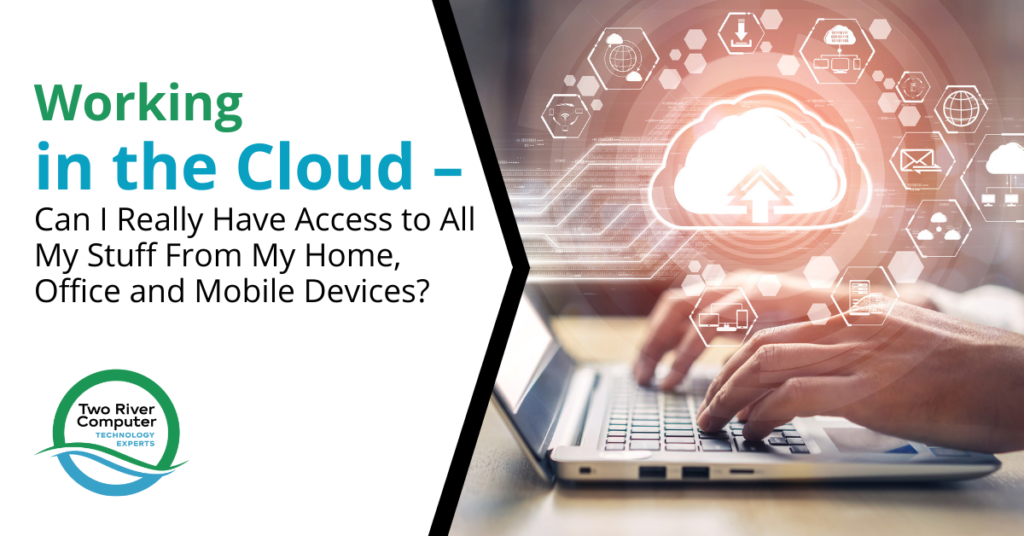
There used to be a time when all your files were always stored in only one place. It was usually your computer hard drive or an office server. If you had to take work home with you or wanted to send a picture to a friend, you had two main options. You had to email the file, hoping it wasn’t too large to send or save it to a disk or UBS drive.
This system was and still is, clunky and inefficient. For example, what if you need to work on several files from different locations… how long will it take to copy all those files to a disk? What if you accidentally forget which file is the newest and overwrite your work?
Most people have also experienced the frustration of continually trying ways to email a file to someone, only to have it keep being rejected because it’s too big.
The cloud changed all that.
When cloud computing came along, suddenly people could access files from any location. They could also backup and recover data easily from any device. This has had a huge impact on both home and business technology and the ability to work from anywhere.
62% of people say they work remotely from home at least part of the time.
How Does the Cloud Work?
What we call “The Cloud” is actually millions of servers that are in data centers. They are owned by companies like Google, Microsoft, Apple, Amazon, and many others. These servers store files and applications that people from around the world use.
Without the internet, there would be no cloud. It enables you to go online and connect remotely to one of those many cloud servers out there in those data centers. If you access Facebook on your mobile device, then you’re connected to a server run by Facebook that hosts its application and has your profile data stored on it.
If you log into your Microsoft 365 account for work, then you’re connecting to a server owned by Microsoft that hosts all your account’s data and applications.
The benefit of having applications and data stored on those cloud servers rather than on your own computer’s hard drive include:
-
- You can access your data from any location
- You can access your data from any device (home or work PC, tablet, smartphone)
- You can work online with others at the same time
- You don’t have to worry about data being lost if your computer crashes
- It’s much easier to share files with others
Main Ways We Use the Cloud
Cloud Storage
One of the main uses of cloud computing is cloud storage. Applications like Google Drive, One Drive, Dropbox, etc. allow you to use their interfaces to upload and access documents, videos, music, pictures, and other files.
All you need is your login credentials to access your files from any location and any internet-connected device.
Other benefits of cloud storage include:
- Enables you to easily share files using links
- Has file organization capabilities (like flagging and color-coding)
- Files are stored securely if you’re using a well-known cloud provider
- Don’t have to waste time trying to email files back and forth or copy them to a portable USB drive
Cloud Applications
Cloud applications go a step beyond just storing your files in the cloud, they allow you to work within a software environment via an online connection. So, instead of having to install software on your computer, you can simply access a cloud application through your browser or via a desktop or mobile app.
Popular cloud applications include tools like Slack, QuickBooks Online, Salesforce, Zoom, Zendesk, and others. This category also includes social media sites like Facebook, Instagram, and LinkedIn.
The ability to access work applications from any location has enabled the rise of remote working. Even before it was greatly accelerated by the pandemic, remote work was growing in popularity.
Hybrid Cloud Applications
Hybrid cloud applications are those that give you the ability to work online in the cloud AND offline on your computer. One of the most popular hybrid cloud applications is the Office programs in Microsoft 365.
You can install the software for Word, Excel, and the other programs on your computer (just like in the “old days”), and work in them offline if you like. You can also work in the Office web-based apps and sync your offline files with your cloud storage to keep that anywhere access benefit.
Another popular hybrid cloud suite is from Adobe. Their Lightroom, Photoshop, and other graphics tools are also available to work with both online and offline.
Are You Using the Cloud Securely & Efficiently?
Working in the cloud can easily get complicated if you don’t have a plan in place. Two River Computer can help you navigate the cloud and put together an effective strategy that enhances your workflow.
Contact us today for a free consultation. Call 732-747-0020 or reach us online.


